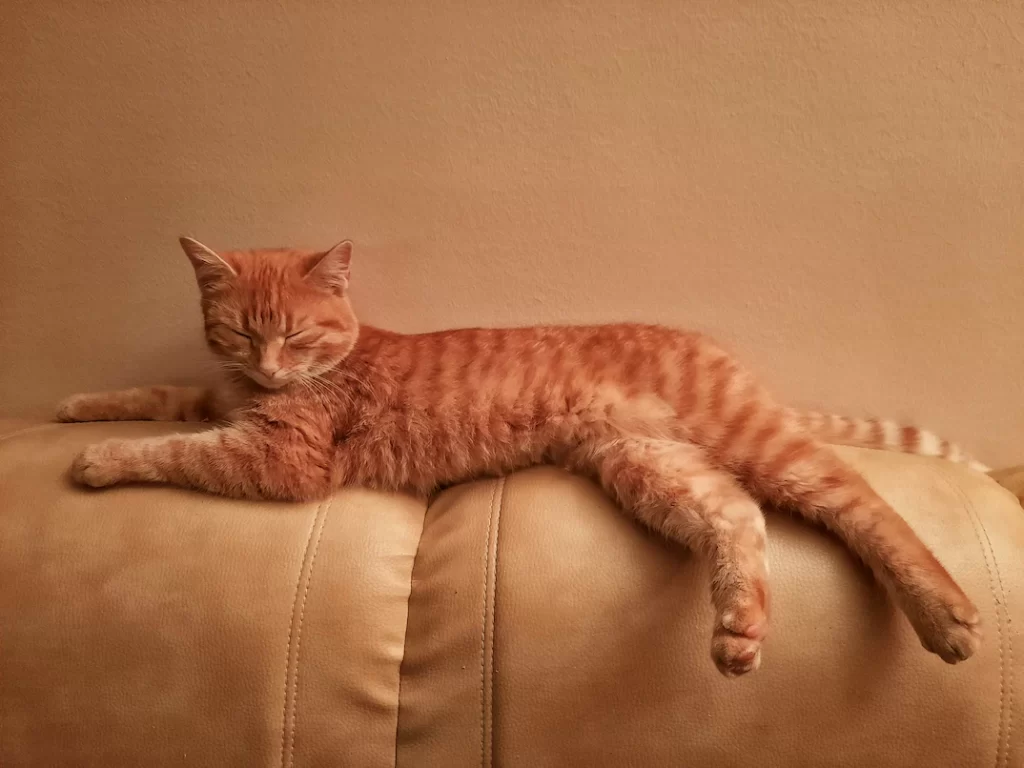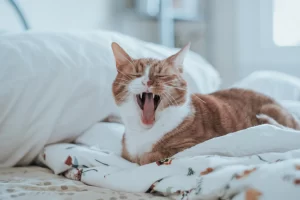Last updated on February 2nd, 2023 at 05:53 am

Your new couch is in shambles, your cushions are destroyed, and your carpet resembles a war zone. Who is the perpetrator? Your cute little kitty, all innocent as she smashes all your good stuff by herself. You may feel like giving up and handing over your house to the cat, but don’t! It’s more accessible than it sounds to teach cats, not to scratch. How can you protect your furniture from these lovely little kitties? Can you train them to scratch different objects instead? It only takes a little understanding, some forethought, and a pair of cat scratchers. In this article, we will explore some safe ways to stop your cats from scratching the furniture and provide your cat have secure scratching areas.
What makes cats scratch furniture?
It is by nature that cats are born scratchers; it is a behavioral part of every member of the cat family to scratch. For that, cats will always find objects to strike, and furniture provides a good spot for scratching. Cats scratch to relieve stress and boredom; through scratching, cats remove the dead cells of their claws as they sharpen them. Why do cats scratch furniture? The following are the primary reasons:
- To remove the claws’ outer coating.
Cats scratch items instinctively to cut their nails. If an outer layer of their claws is ready to come off when they scratch, running them through a nobby object will capture the dead layer and remove it for them.
- To mark their territory.
When the cat scratches the furniture, they leave visible marks. But did you realize that this procedure also leaves its own aroma behind? The paws of a cat are enriched with scent glands that leave a given scratched spot in the cat’s aroma to mark the cat’s territory.
- It’s a side effect of stretching.
Cats are flexible. Their claws protrude as they stretch. They don’t think to keep their claws in, especially for your sake, so they immediately come out as they stretch.
So, your beloved cat is just a cat. It’s less fun if they decide to leave their mark on your furniture, draperies, or carpeting. For this reason, we have developed tested methods to stop the cat from scratching your furniture.
How do you ensure your cat puts an end to scratching your furniture?
With your information, you now know why cats scratch your walls, carpet, and other furniture. Now, let us dive into ways to stop this habit in cats and further direct it to a specific area to scratch.
Ensure you provide alternative suitable scratching areas
Naturally, cats are climbers and prefer vertical scratching points, as some prefer horizontal ones. For your cats to stretch out freely, the vertical poles need to be strong, stable, and long enough; In case you have several cats, you should have various scratching areas to reduce competition. These scratching points should be placed near your cat’s preferred spots, like the windows, the couches, and the areas where the cats prefer to slumber. The function of the scratching points is to help stop the cat’s habit of scratching furniture.
While supporting the cat’s needs, it is advisable to consider certain things that protect the furniture. These may include: leg wraps like sisal mat wraps or wrapping the furniture’s legs in certain materials like cotton tape.
You can also point the cat to a given scratching point by using doormats, dispensers that release food when scratched, and wall-mounted brushes to mark faces.
In addition, one can install tree branches and even certain logos on the balcony
Cats born with orthopedic issues can be taught how to reach higher areas. This can be due to either using vertical or horizontal poles as links to rise to higher levels. Using a non-slip cushion rug combined with discontinued carpet samples ensures senior cats have different scratching possibilities.
Sprays, Tapes, and Additional Repellents
The habit of cats scratching the furniture is terrible, but there may be better answers to obtaining a scratching post. Use sticky paws– these adhesive tapes are double-sided and can cover furniture to protect them from cat scratches. In an attempt to scratch, the cat’s paws stick on the tape, and the irritation will prevent the cat from scratching—this way, the furniture is protected from damage, and the cat is taught to scratch the intended objects.
Another effective way of protecting your furniture is using herbal sprays. There are available commercial herbal-based products that are not harmful to cats. These products are natural barriers. Occasionally spraying them on your furniture creates an annoying environment for the cat, which prevents them from scratching.
There are also a few ways in which you can trim your cats’ claws as a measure of reducing damage to your furniture. Using a cat nail trimmer, these items are readily available from pet stores and are specifically made to reduce cats’ claws. When using these trimmers, ensure you avoid cutting the pink nail area. This area is sensitive and can cause pain to your cat. You can also consider filling the claws.
If you possess a friendly cat, gently use a nail file to file down the claws. There are also soft paw caps available That you can use to cover your cats’ claws to protect your home furniture. These are easy to use and are comfortably designed.
Use toys and food reinforcement to train your cats
Use a toy to play with the cat near the pole, and make the cat’s claws touch the pole as it swipes. Or tie the toy to the scratching pole with a rope and bring the cat to grab it.
Alternatively, you can overturn the scratching post and add catnip powder. However, it is still being determined if catnip will automatically draw that cat to the scratching post. It is good to try various alternatives, like playing with your cat near a corrugated scratching pad. This will take the cat’s head from scratching furniture to playing with the toys.
Kitties that love food can easily be teased with delights. You can start by rewarding the kitties for sniffing and exploring the scratching pole. Gradually give an excellent treat to the point the cats scratch the pole. Placing the highest treat on top of the pole will motivate the cats to climb to retrieve the reward. Do not rub your cat’s paws against the post; this will scare them and make them resent the post if they find it upsetting. Lastly, to entice the cat, ensure you scratch the post daily.
Ensure your cat’s nails are regularly trimmed
Like human fingernails, cats’ claws also grow regularly and become sharper. So cats scratch as a mechanism to shed off the old outer layers to be replaced with new developing nails. Trimming your cat’s nails after every two weeks or monthly keeps your cat’s nails in check. Wild cats do not need their claws trimmed since they use them for survival. Old cats must have their nails trimmed monthly to reduce their fragile nature.
Always ensure to train your cat to love nail trimming at home. Please do not force it. If your cat dislikes getting its nails cut, take them to the vet or contact a professional cat groomer.
Removing your cat’s claws is not the solution
Many prefer declawing their cats, but that is not a good idea. Declawing is a painful process, and since there are ways to prevent your cat from scratching your furniture, it is unnecessary. Cats need their claws for their everyday existence. Declawing, in a way, renders them handicapped as the claws help give them balance. When removed, your cat will have to learn to walk again. It is an inhumane act and prohibited in most countries.
Creating Your Repellent Spray
The solution to having a repellant spray to protect your furniture is not in the store. The sprays may not only be harmful to the cats alone. Nonetheless, it may be unsafe for humans, unavailable at your local pet store, or both.
There’s no need to worry because the ingredients for a homemade spray that keeps your cat from scratching furniture may be found in a few different recommendations. But before you spray them on your prized possessions, test them in a hidden location to ensure they don’t leave any stains.
One cup of water and 1 cup of unfiltered apple cider vinegar. Spray them on your chair, bedpost, door, and anything else your cat might damage by scratching the woodwork.
If you’re worried about the smell, you should know that the human nose cannot detect this blend.
If you are skeptical about the efficacy of apple cider, try combining lemon essential oil, rosemary, vegetable glycerin, and water instead. This will keep your furry buddy away and leave a fresh scent on your furniture.
Conclusion
Scratching is so innate that even cats with claws removed attempt to scratch. It is good to tolerate your cat before taking further steps. If you take action for your cat scratching the wrong place, you might trigger anxiety in that cat, which could potentially cause further problems.
Take your time with your cat; try different ways and substrates for some time. When the cats scratch the right places, give them praise and good treats. It is possible to create unique scratching solutions for cats depending on their needs and simultaneously improve our interactions with the cats. This is only possible if we consider the cats’ behavior patterns and communication.


